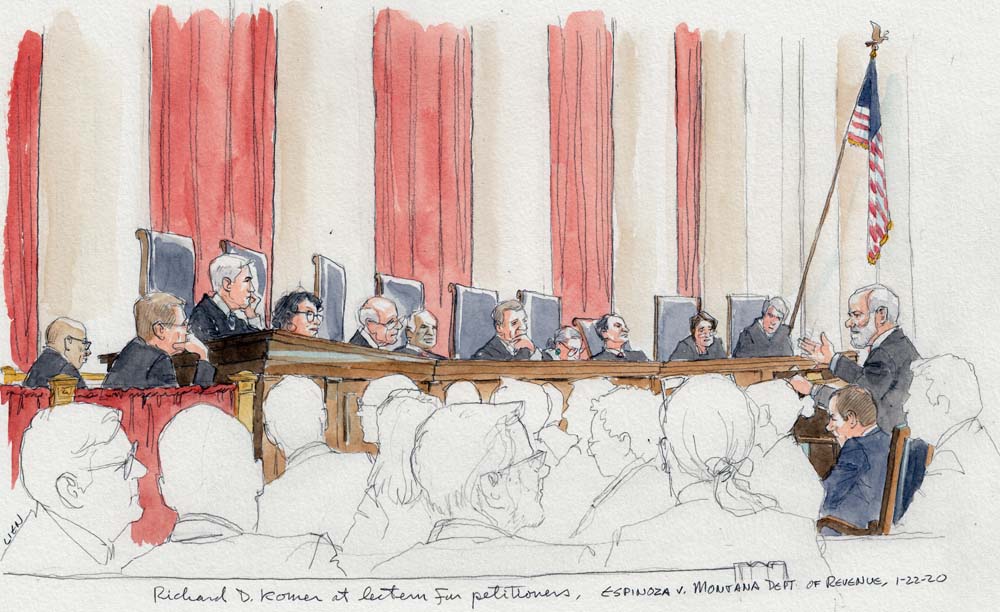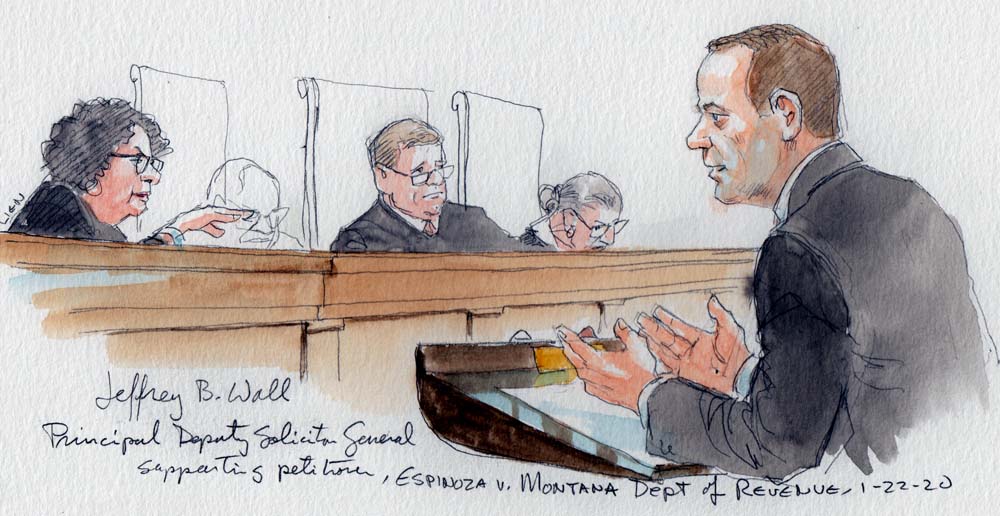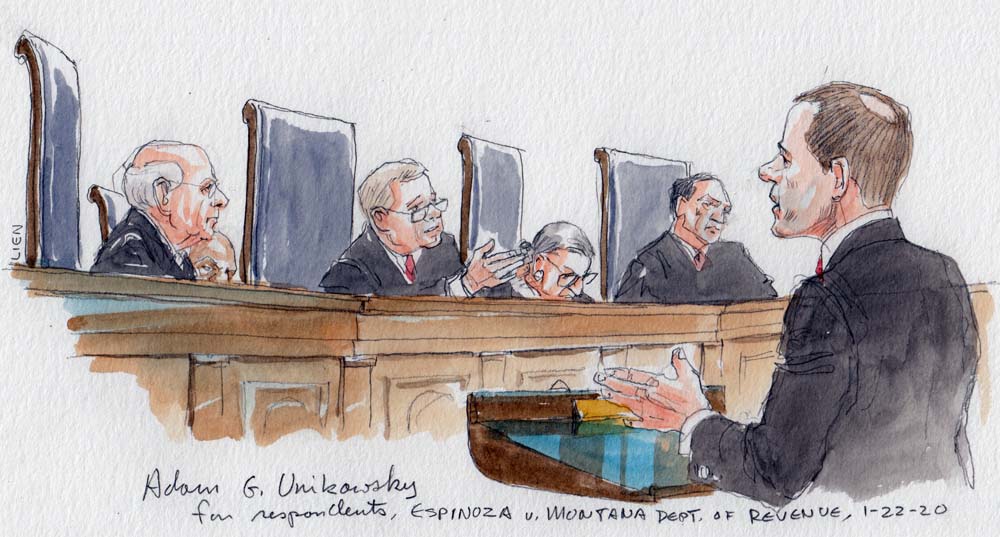Argument analysis: Justices divided in Montana school-choice case


This morning the Supreme Court heard oral argument in the latest chapter of the battle over the use of public funding for religious schools. Supporters of such funding argue that the government should not be allowed to discriminate against religious families and schools, while opponents warn that requiring the government to allow public funds to be used for religious schools could harm public education. Both of those issues were at the forefront of today’s oral argument, as was the question of whether the lawsuit should continue at all. By the time the justices left the bench, it appeared that the outcome could hinge on the votes of Chief Justice John Roberts and Justice Stephen Breyer.

The issue came to the court in a challenge to a ruling by the Montana Supreme Court that invalidated a tax-credit program on the ground that the scholarships created by the program could be used at religious schools. In 2015, the Montana legislature established the program, which provides a dollar-for-dollar tax credit of up to $150 for individuals and businesses who donate to private scholarship organizations. The organizations then use the donated money to provide scholarships for students who want to attend private schools – which, in Montana, are overwhelmingly religious. But under a rule announced by the Montana Department of Revenue shortly after the program was passed, families could not use the scholarships at religious schools. Doing so, the department explained, would violate the state constitution’s ban on aid for churches and religious schools.
Kendra Espinoza, a single mother of two daughters, and two other Montana mothers went to court to challenge the rule. Explaining that they were “counting on” the scholarship money to able to keep their children in a Christian school in Kalispell, Montana, they argued that the exclusion of religious schools from the program would violate the federal constitution. The Montana Supreme Court rejected that argument, holding that the tax-credit program violated the state constitution because families were allowed to use the scholarships at religious schools. Espinoza asked the U.S. Supreme Court to review that ruling, which the justices agreed last June to do.
Arguing for Espinoza and the other parents challenging their exclusion from the tax-credit program, lawyer Richard Komer told the justices that the question before them was whether the federal constitution allows the “wholesale exclusion” of religious schools from a state scholarship program. The answer, Komer continued, is that it does not.
During his time at the lectern, Komer faced a barrage of questions from the court’s female justices about whether his clients had a legal right to be in court at all, known as “standing.” Justice Ruth Bader Ginsburg was first out of the gate. Now that the program is no longer in place, Ginsburg observed, Espinoza and the other parents are not being treated any differently than the parents of children attending private secular schools. Where, Ginsburg enquired, is the harm? Moreover, Ginsburg continued, the parents in this case are not the taxpayers, so under the Supreme Court’s cases they would not have a legal right to challenge the availability of the tax credit.
Justice Sonia Sotomayor chimed in to make a similar point. Is there any Supreme Court case, she asked Komer, in which the justices recognized the legal right to sue of a party who didn’t pay taxes or receive them? The parents in this case are, Sotomayor suggested, “like three levels removed”: They aren’t the taxpayers receiving the credits, they aren’t the schools receiving the money from the state, and there is no guarantee that their children will receive scholarships.

Roberts also raised a question about the parents’ right to sue. Shortly after Jeffrey Wall, the deputy solicitor general who argued on behalf of the federal government in support of the parents, finished his opening remarks, Roberts jumped in. The injury in this case, Roberts said to Wall, “flows through the schools,” because the money goes to the schools, rather than the parents. And there are, Roberts observed, no schools in this case.
Justice Elena Kagan joined the fray as well. No matter what label you put on it, she told Komer, I “am having trouble seeing where the harm is in this case” right now. Whether “you go to a religious school or you go to a secular private school,” she noted, “you’re in the same boat at this point.” There’s no actual discrimination happening, she emphasized.
Komer pushed back, arguing that the discrimination occurred when the Montana Supreme Court issued its decision “mistakenly believing” that the state constitutional provision banning aid for religious schools and its application “did not violate the Federal Constitution.” The remedy that the Montana Supreme Court decided on – striking down the whole tax-credit program – did not “shield the discriminatory judgment,” Komer continued.
Kagan was unpersuaded, countering that the Supreme Court does not “usually grade every line of an opinion.” Instead, she said, the justices look at the consequences of the lower court’s decision: Here, there is no discrimination because the consequence of the Montana Supreme Court’s ruling was that no one got the scholarship money.
Justice Samuel Alito pushed back. Under the Supreme Court’s cases, he asked Komer, would it be unconstitutional for a state government agency to do something that it was allowed to do, but for an unconstitutional reason? Komer responded that it would.
A second major question at today’s argument followed from the Supreme Court’s 2017 ruling in Trinity Lutheran Church v. Comer, holding that Missouri’s policy of excluding churches from a program to provide grants to resurface playgrounds violated the Constitution. In a footnote in his opinion for the court in Trinity Lutheran that Justices Neil Gorsuch and Clarence Thomas did not join, Roberts stressed that the court’s decision was limited to the facts before it and did “not address religious uses of funding or other forms of discrimination.”

Komer told the justices that his clients’ case was “just like Trinity Lutheran” and that states cannot discriminate on the basis of religion. Alito and Justice Brett Kavanaugh seemed to agree. Why, Kavanaugh asked Adam Unikowsky, who argued on behalf of Montana, isn’t this case a “straight violation” of Trinity Lutheran? If you are running a scholarship program in which people are denied or granted funding depending on their religious status, how is that consistent with Trinity Lutheran? Kavanaugh also had strong words for Unikowsky about the state’s “no aid” clause, describing the clause as “rooted in grotesque religious bigotry against Catholics.”
Alito echoed Kavanaugh’s thoughts, asking Unikowsky whether there is “any real difference between this and Trinity Lutheran?”
Kagan saw things differently. Trinity Lutheran, Kagan explained to Wall, involved a completely secular benefit, while here Montana is saying that it doesn’t want to subsidize religious education or activity. “That’s a far cry from Trinity Lutheran,” Kagan concluded.
Breyer and Roberts both expressed concern about what the broader implications of a ruling for the parents might be – specifically, whether it might affect government funding for public schools. Both Wall and Komer focused on the narrower question before the justices, with Komer emphasizing that his clients were in the Supreme Court only because Montana offered funding beyond the public schools. “We are not arguing,” Komer said, “that the state couldn’t just fund public schools.”
By the time Komer finished, it seemed all but certain that he had the votes of Alito and Kavanaugh, and it seemed likely that Unikowsky had the votes of Ginsburg, Sotomayor and Kagan. Justice Neil Gorsuch said relatively little, and Justice Clarence Thomas asked no questions at all, but their votes in Trinity Lutheran suggest that they are likely to be sympathetic to the parents. This means that the outcome will likely rest on the votes of Roberts and Breyer, whose questions centered largely on the public-school funding issue. A decision in the case is expected by summer.
[Disclosure: Goldstein & Russell, P.C., whose attorneys contribute to this blog in various capacities, is counsel on an amicus brief in support of the respondent in this case. The author of this post is not affiliated with the firm.]
This post was originally published at Howe on the Court.
Posted in Merits Cases
Cases: Espinoza v. Montana Department of Revenue
